Page 20 of 711
Your vehicle at a glance
8 2
INSTRUMENT PANEL OVERVIEW
1. Lighting control lever ......................4-122
2. Audio remote control buttons ..........4-191
3. Bluetooth hands-free buttons ..........4-241
4. Cruise control button ........................5-64
5. LCD display control buttons ..............4-58
6. Horn ..................................................4-45
7. Driver’s front air bag ..........................3-58
8. Wiper and washer control lever ......4-131
9. Ignition switch or Engine start/stop
button ........................................5-6, 5-10
10. Audio ............................................4-190
11. Hazard warning flasher ................4-120
12. Climate control system ......4-143, 4-155
13. Passenger’s front air bag ................3-58
14. Glove box ......................................4-174
ODM012004❈The actual shape may differ from the illustration.
■Left-Hand drive type
Page 21 of 711
29
Your vehicle at a glance
1. Lighting control lever ......................4-122
2. Audio remote control buttons ..........4-191
3. Bluetooth hands-free buttons ..........4-241
4. Cruise control button ........................5-64
5. LCD display control buttons ..............4-58
6. Horn ..................................................4-44
7. Driver’s front air bag ..........................3-58
8. Wiper and washer control lever ......4-131
9. Ignition switch or Engine start/stop
button ........................................5-6, 5-10
10. Audio ............................................4-190
11. Hazard warning flasher ................4-120
12. Climate control system ......4-143, 4-155
13. Passenger’s front air bag ................3-58
14. Glove box ......................................4-174
ODMEIN2004R❈The actual shape may differ from the illustration.
■Right-Hand drive type
Page 105 of 711
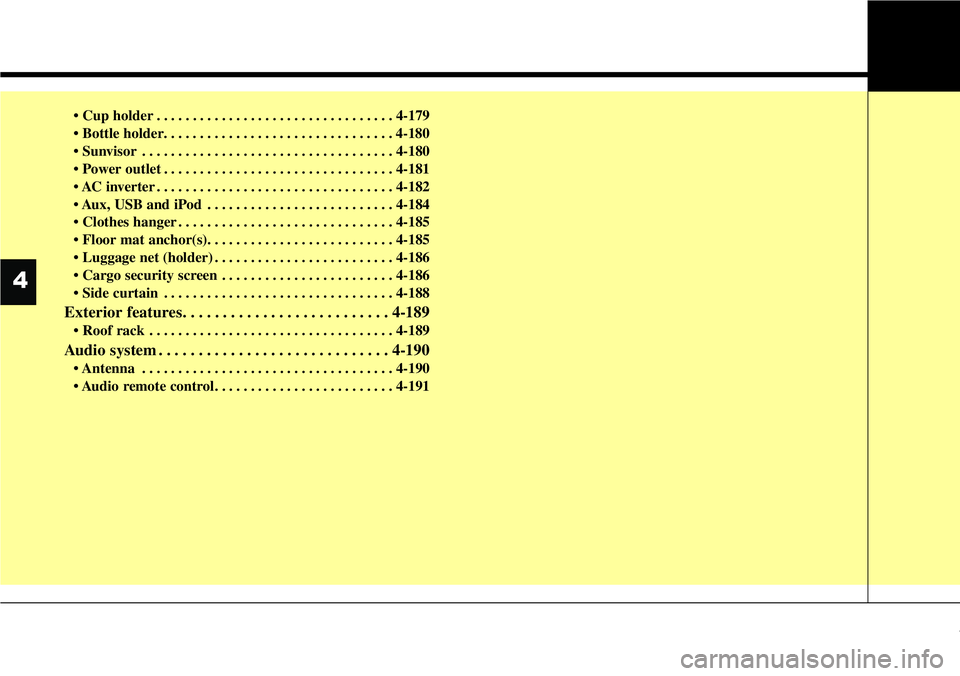
• Cup holder . . . . . . . . . . . . . . . . . . . . . . . . . . . . . . . . . 4-179
• Bottle holder. . . . . . . . . . . . . . . . . . . . . . . . . . . . . . . . 4-180
• Sunvisor . . . . . . . . . . . . . . . . . . . . . . . . . . . . . . . . . . . 4-180
• Power outlet . . . . . . . . . . . . . . . . . . . . . . . . . . . . . . . . 4-181
• AC inverter . . . . . . . . . . . . . . . . . . . . . . . . . . . . . . . . . 4-182
• Aux, USB and iPod . . . . . . . . . . . . . . . . . . . . . . . . . . 4-184
• Clothes hanger . . . . . . . . . . . . . . . . . . . . . . . . . . . . . . 4-185
• Floor mat anchor(s). . . . . . . . . . . . . . . . . . . . . . . . . . 4-185
• Luggage net (holder) . . . . . . . . . . . . . . . . . . . . . . . . . 4-186
• Cargo security screen . . . . . . . . . . . . . . . . . . . . . . . . 4-186
• Side curtain . . . . . . . . . . . . . . . . . . . . . . . . . . . . . . . . 4-188
Exterior features. . . . . . . . . . . . . . . . . . . . . . . . . . 4-189
• Roof rack . . . . . . . . . . . . . . . . . . . . . . . . . . . . . . . . . . 4-189
Audio system . . . . . . . . . . . . . . . . . . . . . . . . . . . . . 4-190
• Antenna . . . . . . . . . . . . . . . . . . . . . . . . . . . . . . . . . . . 4-190
• Audio remote control. . . . . . . . . . . . . . . . . . . . . . . . . 4-191
4
Page 282 of 711
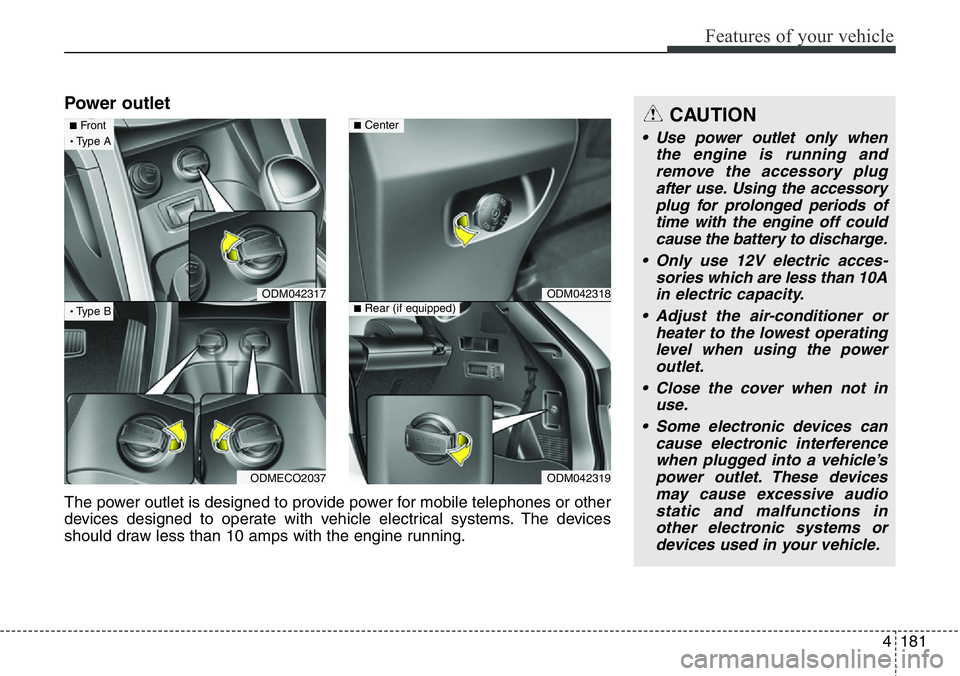
4181
Features of your vehicle
Power outletCAUTION
• Use power outlet only when
the engine is running and
remove the accessory plug
after use. Using the accessory
plug for prolonged periods of
time with the engine off could
cause the battery to discharge.
• Only use 12V electric acces-
sories which are less than 10A
in electric capacity.
• Adjust the air-conditioner or
heater to the lowest operating
level when using the power
outlet.
• Close the cover when not in
use.
• Some electronic devices can
cause electronic interference
when plugged into a vehicle’s
power outlet. These devices
may cause excessive audio
static and malfunctions in
other electronic systems or
devices used in your vehicle.
ODM042318
ODM042319
■Center
■Rear (if equipped)
The power outlet is designed to provide power for mobile telephones or other
devices designed to operate with vehicle electrical systems. The devices
should draw less than 10 amps with the engine running.
ODM042317
ODMECO2037
■Front·Type A
·Type B
Page 285 of 711
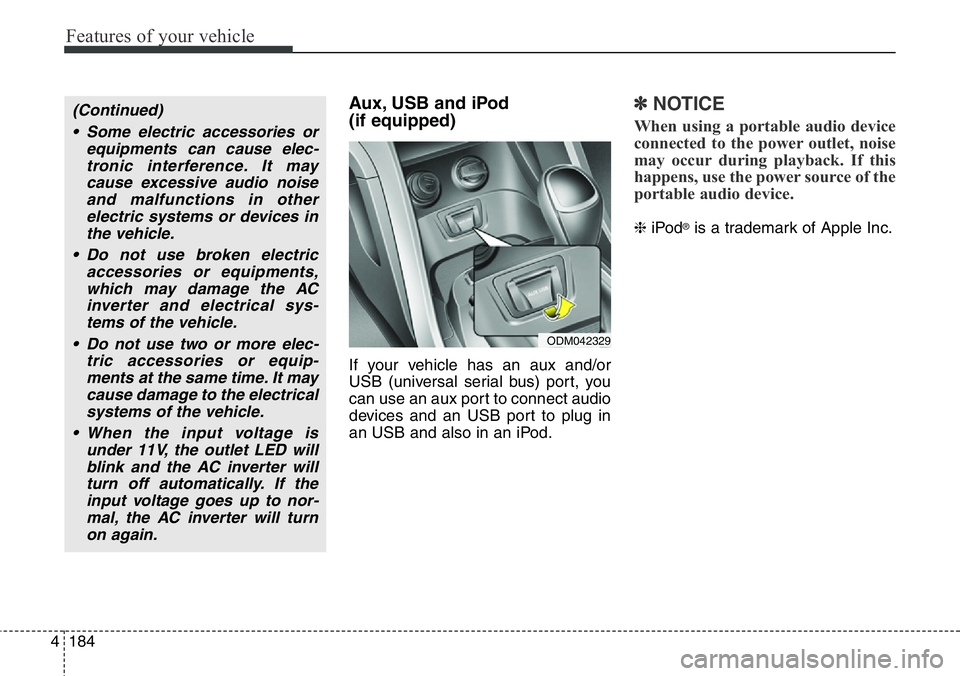
Features of your vehicle
184 4
Aux, USB and iPod
(if equipped)
If your vehicle has an aux and/or
USB (universal serial bus) port, you
can use an aux port to connect audio
devices and an USB port to plug in
an USB and also in an iPod.
✽NOTICE
When using a portable audio device
connected to the power outlet, noise
may occur during playback. If this
happens, use the power source of the
portable audio device.
❈iPod®is a trademark of Apple Inc.
ODM042329
(Continued)
• Some electric accessories or
equipments can cause elec-
tronic interference. It may
cause excessive audio noise
and malfunctions in other
electric systems or devices in
the vehicle.
• Do not use broken electric
accessories or equipments,
which may damage the AC
inverter and electrical sys-
tems of the vehicle.
• Do not use two or more elec-
tric accessories or equip-
ments at the same time. It may
cause damage to the electrical
systems of the vehicle.
• When the input voltage is
under 11V, the outlet LED will
blink and the AC inverter will
turn off automatically. If the
input voltage goes up to nor-
mal, the AC inverter will turn
on again.
Page 291 of 711
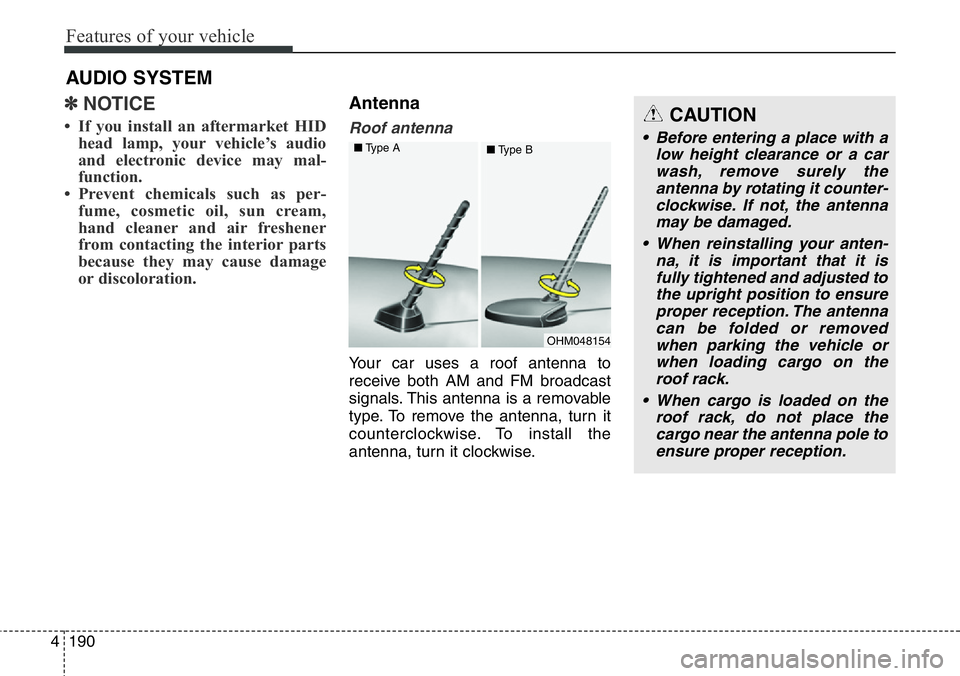
Features of your vehicle
190 4
✽NOTICE
• If you install an aftermarket HID
head lamp, your vehicle’s audio
and electronic device may mal-
function.
• Prevent chemicals such as per-
fume, cosmetic oil, sun cream,
hand cleaner and air freshener
from contacting the interior parts
because they may cause damage
or discoloration.
Antenna
Roof antenna
Your car uses a roof antenna to
receive both AM and FM broadcast
signals. This antenna is a removable
type. To remove the antenna, turn it
counterclockwise. To install the
antenna, turn it clockwise.
AUDIO SYSTEM
CAUTION
• Before entering a place with a
low height clearance or a car
wash, remove surely the
antenna by rotating it counter-
clockwise. If not, the antenna
may be damaged.
• When reinstalling your anten-
na, it is important that it is
fully tightened and adjusted to
the upright position to ensure
proper reception. The antenna
can be folded or removed
when parking the vehicle or
when loading cargo on the
roof rack.
• When cargo is loaded on the
roof rack, do not place the
cargo near the antenna pole to
ensure proper reception.
OHM048154 ■Type A
■Type B
Page 292 of 711
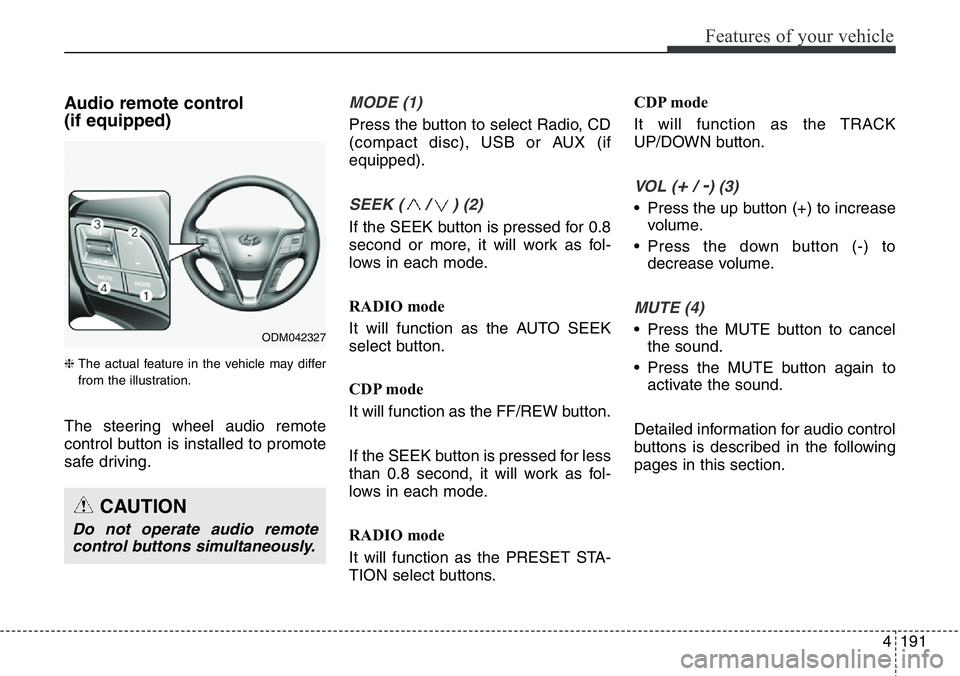
4191
Features of your vehicle
Audio remote control
(if equipped)
❈ The actual feature in the vehicle may differ
from the illustration.
The steering wheel audio remote
control button is installed to promote
safe driving.
MODE (1)
Press the button to select Radio, CD
(compact disc), USB or AUX (if
equipped).
SEEK ( / ) (2)
If the SEEK button is pressed for 0.8
second or more, it will work as fol-
lows in each mode.
RADIO mode
It will function as the AUTO SEEK
select button.
CDP mode
It will function as the FF/REW button.
If the SEEK button is pressed for less
than 0.8 second, it will work as fol-
lows in each mode.
RADIO mode
It will function as the PRESET STA-
TION select buttons.CDP mode
It will function as the TRACK
UP/DOWN button.
VOL (+/ -) (3)
• Press the up button (+) to increase
volume.
• Press the down button (-) to
decrease volume.
MUTE (4)
• Press the MUTE button to cancel
the sound.
• Press the MUTE button again to
activate the sound.
Detailed information for audio control
buttons is described in the following
pages in this section.
CAUTION
Do not operate audio remote
control buttons simultaneously.
ODM042327
Page 293 of 711
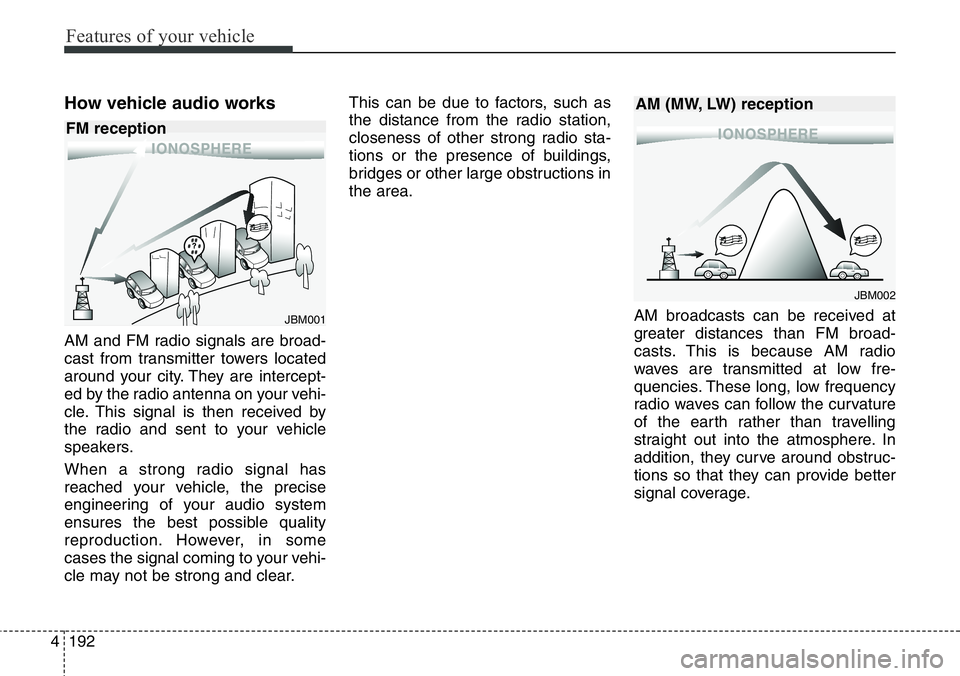
Features of your vehicle
192 4
How vehicle audio works
AM and FM radio signals are broad-
cast from transmitter towers located
around your city. They are intercept-
ed by the radio antenna on your vehi-
cle. This signal is then received by
the radio and sent to your vehicle
speakers.
When a strong radio signal has
reached your vehicle, the precise
engineering of your audio system
ensures the best possible quality
reproduction. However, in some
cases the signal coming to your vehi-
cle may not be strong and clear.This can be due to factors, such as
the distance from the radio station,
closeness of other strong radio sta-
tions or the presence of buildings,
bridges or other large obstructions in
the area.
AM broadcasts can be received at
greater distances than FM broad-
casts. This is because AM radio
waves are transmitted at low fre-
quencies. These long, low frequency
radio waves can follow the curvature
of the earth rather than travelling
straight out into the atmosphere. In
addition, they curve around obstruc-
tions so that they can provide better
signal coverage.
JBM001
JBM002
FM receptionAM (MW, LW) reception